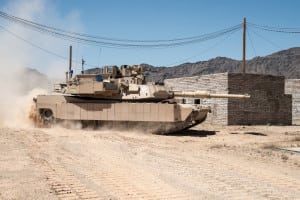Leonardo DRS is readying to complete deliveries of the Trophy Active Protection System (APS) program for Army Abrams tanks by the end of year, while pursuing continued interest in an updated, lighter version of the system with a new characterization event set for mid-2021.
“We’re wrapping up those deliveries now. It’s been a yearlong rapid production process since the directed requirement in 2016 to outfit four brigades of Abrams with Trophy APS capability,” Mike O’Leary, Leonardo DRS Land Systems’ senior director of business development, told
Defense Daily.

The Army has awarded over $200 million to Leonardo DRS, and its partner Israel’s Rafael, for the Trophy APS program, which looks to outfit its Abrams tanks with a mature, ready-for-deployment anti-tank missile capability (Defense Daily, Jan. 8 2019).
O’Leary noted the Army utilized Trophy on its Abrams during the Defender 2020 exercise in Europe over the summer to continue refining the operational use for the new capability.
“The Army was able to get some invaluable experience in logistics, sustainment, operations, maintenance and training of the system on the tanks,” O’Leary said. “There were a lot of lessons learned. And we think for deployability, transportability and maintainability, it answered a lot of questions that the field Army needed.”
Leonardo DRS is now further gauging interest in the lighter, updated version capability, called Trophy VPS, which could be aimed at platforms such as Bradleys, Strykers or the future Optionally Manned Fighting Vehicle.
“It’s more than a hard kill [capability]. It’s improved detection. It’s an optional soft kill capability that we’re building into it,” O’Leary said. “The idea is to build on that lighter weight, streamlined capability for lighter weight platforms, like the Stryker or the future [Optionally Manned Fighting Vehicle]. That’s our focus for Trophy VPS, the more holistic, state-of-the-art, more advanced to deal with a broader spectrum of threats.”
O’Leary said Trophy VPS, which is 40 percent lighter than the baseline system, is intended to meet the Army’s call for multi-mission capabilities that take advantage of existing tools that can be applied for a range of operational use cases.
“That’s what we’re focused on, improving existing capabilities to do more missions. The types of threats are only growing and we can’t just keep tacking on new capabilities because of size, weight and power concerns,” O’Leary said.
In 2018, the company demonstrated Trophy VPS on a Bradley in Israel and last year they did a system-level characterization on a Stryker surrogate vehicle.
Next year’s characterization event is intended to help the Army address how it might use a lighter system as it explores potentially pursuing such a capability.
“That’s going to attempt to answer several key questions that the Army has,” O’Leary said. “There are some narrowly-defined performance areas that the Army is really trying to nail down that vehicle protection can take care of, whether it’s our system or other systems, before they commit to the type of VPS that they would employ on a much lighter weight platform, like a Stryker or future platforms.”
Leonardo DRS is also exploring options for partnering with potential prime contractors for the Army’s rebooted OMFV competition that may be interested in utilizing Trophy VPS for their offerings.
“We think the enhanced capability Trophy VPS provides with broader performance options is exactly what is needed in that evolving threat environment, the type of environments that [OMFV] is going to operate in,” O’Leary said. “We’re not stopping our efforts to either refine and mature our offering, as well as discussing the capability with prospective prime contractors.”